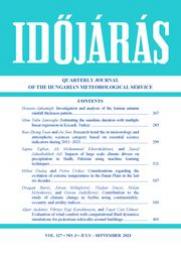IDŐJÁRÁS - angol nyelvű folyóirat
Vol. 127, No. 3 * Pages 267–420 * July - September 2023
 |
|
 letöltés [pdf: 3023 KB]
letöltés [pdf: 3023 KB]
Contribution to the study of climate change in Serbia using continentality, oceanity, and aridity indices
Dragan Burić, Jovan Mihajlović, Vladan Ducić, Milan Milenković, and Goran Anđelković
DOI:10.28974/idojaras.2023.3.6 (pp. 379–399)
Dragan Burić, Jovan Mihajlović, Vladan Ducić, Milan Milenković, and Goran Anđelković
DOI:10.28974/idojaras.2023.3.6 (pp. 379–399)
IDŐJÁRÁS folyóirat

Az IDŐJÁRÁS a HungaroMet Nonprofit Zrt. negyedévenként megjelenő angol nyelvű folyóirata
Megrendelhető a journal.idojaras@met.hu címen.
A szerzőknek szánt útmutató itt olvasható.
Megrendelhető a journal.idojaras@met.hu címen.
A szerzőknek szánt útmutató itt olvasható.









